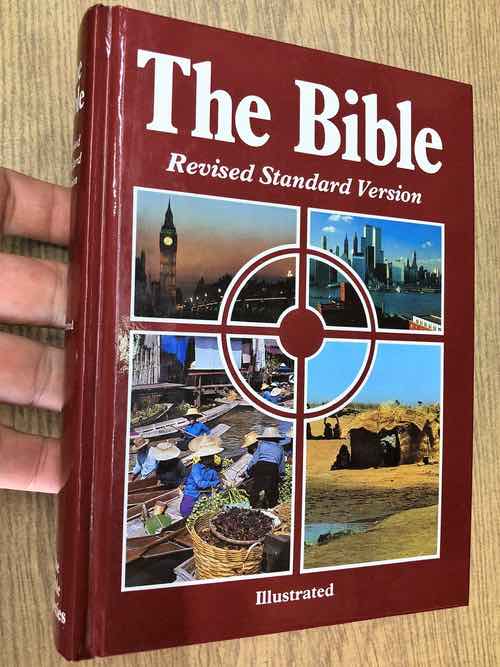
[NB – this post has been rebuilt after this website went down – possibly because of the popularity of this post! LOL]
Today, April 1 2023, is particularly memorable because a courier just pulled up to give me a new version of the Bible, free, to review. The last time that happened was the Mosaic Bible(NLT) in which I was a contributor.
This new version of the Bible is not so much a new translation. Like the ESV, its basis text is the RSV. It is also like the ESV in being the Bible as we wish God had written it. The primary concept of this Bible is drawn from the very-popular YOUCAT Bible. The YOUCAT Bible uses the New Revised Standard Version of the text, but it selects passages, deleting and omitting large tracts of biblical material that would be unhelpful to a young person exploring the Christian faith. Which sections to print and which sections to omit is based on the original German edition Y-Bibel, Jugendbibel de Katholischen Kirche Mit einem Vorwort von Papst Franziskus. This approach also goes back to the 1987 publication of The Bible Revised Standard Version Illustrated by Horace Knowles (see the following image).

The Bible Revised Standard Version Illustrated by Horace Knowles 1987
The Knowles-illustrated Bible was a full Bible (without the apocrypha, however) but it had what many people would call “the boring bits” in a significantly smaller font.
The new Bible version that I received today builds on these approaches. It is a Bible for all ages (so in that way it differs from the YOUCAT Bible which is targeted at young people). It is not a full Bible; it omits difficult, tedious, and repetitive passages – so it is ideal for giving to people (of any age)who are beginning to explore the Christian faith. It doesn’t lead so quickly to those awkward questions about contradictions, God’s wrath and genocidal tendencies, conflict with science and history, misogyny, and so forth. In look and feel, it simply feels like any other Bible – you do not immediately notice, as just one example, that the whole of Leviticus is missing [Leviticus is completely in the tiny font in the Knowles-illustrated Bible.]
How was the choice made as to what to include and what to exclude? The version is titled after its approach: Focusing On Old Lectionaries Updated.
Lectionaries, traditionally, were books that bound together the biblical texts regularly and normally used in services.

Image 28 of Gallican Lectionary, from the Luxeuil Abbey
The image, immediately above, gives a good example of a lectionary from the seventh century (do click on the caption link to explore further). This particular lectionary binds together the readings for services for the year from Christmas Eve onwards. Scholars get an excellent idea from this particular lectionary what, of the Bible, was read and what was not.
The new Bible version I received today follows this approach. Scholars have worked their way through the important old lectionaries to see what parts of the Bible have generally been seen as suitable for the general public at services. These scholars have then chosen from this reduced body of biblical texts the meaningful and readily-comprehensible material and then updated this selection to make sure that all is directly comprehensible to our contemporary context.
So far so good. I am less enthusiastic about the digital version under development – the DigiFOOLUChoose version. In the preface of this publication I received today, there is the announcement that a digital version is being developed, and it is relatively unique in people having some individual choice in what is in and what is not (they argue that this is already the case in choosing Bibles with or without the apocrypha, the extra material treasured by the Orthodox, binding simply one Testament, or even collections of biblical books). For the digital edition, different Christian traditions will be able to have some say in what is included and what is excluded in the particular edition that they are purchasing. Furthermore, not only will people be able to purchase such a digital edition, but they will be able to print “on demand” as many physical versions of their choice as they would wish for (for example, as pew bibles). A couple of examples: those who are against infant baptism will be able to exclude Acts 10 and Acts 16; those who want to focus away from Christ’s divinity will have a thinner version of John’s Gospel and remove more of the Pauline material.
If you are interested in learning more, or ordering a FOOLu version Bible, or pre-ordering the digital version, you get a discount by using the code “APRILONE” at this link.
Do follow:
The Liturgy Facebook Page
The Liturgy Twitter Profile
The Liturgy Instagram
and/or sign up to a not-too-often email


